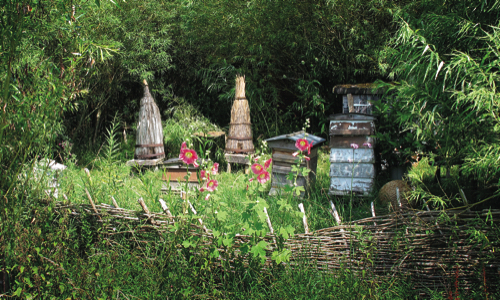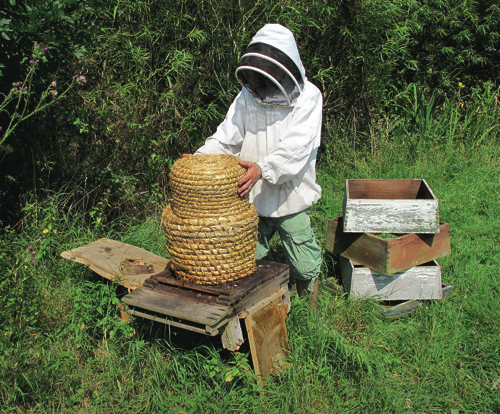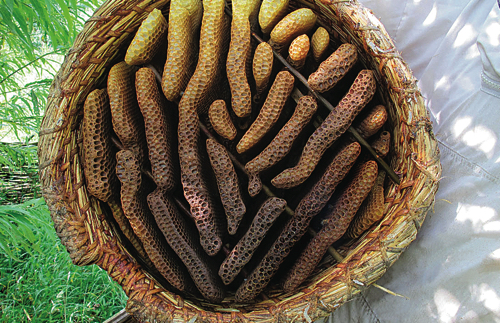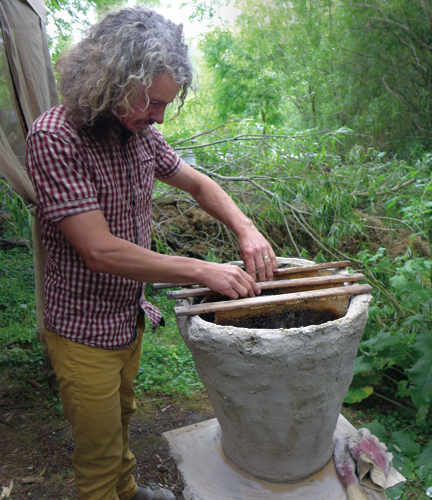 Chris Park has become a familiar figure at UK beekeeping gatherings in recent years, his lectures on historical beekeeping and his skep-making workshops proving ever popular. Bee Craft visited Chris at home to find out more about his skep-making and skep beekeeping.
Chris Park has become a familiar figure at UK beekeeping gatherings in recent years, his lectures on historical beekeeping and his skep-making workshops proving ever popular. Bee Craft visited Chris at home to find out more about his skep-making and skep beekeeping.
On the Wiltshire–Oxfordshire border, below an array of giant wind turbines, a narrow strip of hillside woodland is home to Chris Park, his family and his bees. Almost the whole property is covered in a wilderness of trees and vegetation, with small clearings connected by paths that weave through the undergrowth. The place feels tranquil, enchanted and totally removed from the futuristic world of the nearby wind farm.
Walking through thick stands of willow and hazel, I emerged into Chris’s apiary, a picturesque collection of hives scattered amongst tall grass dotted with flowers. On the sunny day of my visit, it was a bucolic scene reminiscent of the bee gardens depicted in antique books and prints.
Ancient Inspiration
Chris’s route to skep beekeeping can be traced back to his days as a student of sculpture and fine art. ‘I wanted to find out what mankind’s earliest artistic expressions were,’ he explains. ‘In the UK,  that meant studying Celtic and Druidic art, and that led me to visit many ancient sacred sites. It was at these places that I met interesting people who I discovered were Druids. I became fascinated by their beliefs and their approach to life, and I have now been a practising Druid for over 20 years.’
that meant studying Celtic and Druidic art, and that led me to visit many ancient sacred sites. It was at these places that I met interesting people who I discovered were Druids. I became fascinated by their beliefs and their approach to life, and I have now been a practising Druid for over 20 years.’
It was through Druidry that Chris first visited the woodland where he now lives. It was, and continues to be, the site of a sacred grove where Druids meet to celebrate the seasons.
‘Within Druidic stories, spirituality and symbolism, there are lots of references to bees, honey and mead, and this is one of the things that made me want to start keeping bees,’ Chris explains. Reading and researching about beekeeping led Chris to feel that modern methods of bee husbandry didn’t sit comfortably with him. ‘I discovered that at the dawn of what you would call “modern” beekeeping, there was a rush to make money by promoting and selling all kinds of different hive designs, along with all the associated equipment and supplies,’ he says. ‘But people had kept bees in skeps for hundreds, perhaps thousands, of years and I thought that when the old methods were replaced there might have been a fair amount of knowledge lost – a case of the baby being thrown out with the bathwater. I wanted to find out how bees were kept in skeps, and about a technique that had been so successful for such a long period of our history.’
Research and Advice
Having decided he wanted to be a skeppist, Chris looked for guidance. ‘I got in touch with Karl  Showler and David Charles, both of whom gave me advice based on the relatively little experience they had of skep beekeeping. Mostly, they pointed me towards old texts,’ says Chris. ‘I read as much as I could, finding the most useful information in Charles Butler’s The Feminine Monarchie (1609), Andrew Pettigrew’s The Handy Book of Bees (1875) and Thomas Wildman’s A Treatise on the Management of Bees (1768). Some of the old books are quite hard work to read, but I would say that any modern beekeeper could learn a lot from them.’
Showler and David Charles, both of whom gave me advice based on the relatively little experience they had of skep beekeeping. Mostly, they pointed me towards old texts,’ says Chris. ‘I read as much as I could, finding the most useful information in Charles Butler’s The Feminine Monarchie (1609), Andrew Pettigrew’s The Handy Book of Bees (1875) and Thomas Wildman’s A Treatise on the Management of Bees (1768). Some of the old books are quite hard work to read, but I would say that any modern beekeeper could learn a lot from them.’
Making Skeps
Chris experimented with making skeps, using old illustrations as his guide. With my own ham-fisted efforts resembling barely serviceable wastepaper baskets, I can attest that skep-making requires a demanding combination of dexterity, tenacity, strength and artistic judgement. Fortunately, Chris is blessed with these talents and more, having made wicker coracles, built iron-age roundhouses for museums and forged his own tools – not to mention constructing the substantial straw-walled house that he occupies with his family.

Chris’s skeps have evolved over the years, changing slightly in size, shape and design. His material of choice is long-stemmed thatching straw, although in the past he has also made them from wicker, a material thought to have been used before cultivated straw was available. The straw is soaked in water to make it pliable and then tightly twisted to make a sort of straw rope. This rope is then coiled to build-up the body of the skep. Each layer of coil is stitched tightly to the one above using lapping made from split bramble or cane. The lapping is threaded through the straw using a needle made from a hollow bone from the wing of a goose. As the skep grows, the straw rope is continually extended by poking new stalks into the  ends of the previous batch. A cow horn funnel allows the new straw to be pushed into the end of the bundle and holds it all together as it is being worked. The horn is moved along as each section of the skep is completed and more straw is added. One of Chris’s finished skeps is a thing of simple, sculptural beauty. They are also incredibly strong – he stands on them to make the point.
ends of the previous batch. A cow horn funnel allows the new straw to be pushed into the end of the bundle and holds it all together as it is being worked. The horn is moved along as each section of the skep is completed and more straw is added. One of Chris’s finished skeps is a thing of simple, sculptural beauty. They are also incredibly strong – he stands on them to make the point.
Chris’s preferred skep is about 16 inches (41 cm) in diameter and 14 inches (35 cm) in height. The base (or roof) of the skep is flat, with a small hole in the centre. A letterbox entrance is cut into the straw an inch or two above floor level. These skeps are used as brood chambers. Other mini-skeps, without entrances or roof holes, are used as supers.
Wooden sticks called ‘spleets’ are arranged horizontally inside an empty skep. These form scaffolding around which the bees will build their comb, preventing it from moving or falling out when the skep is handled.
Straw skeps are not waterproof and have to be protected from the elements. In the past, shelters called ‘bee boles’ were often built into stone walls, but ‘hackles’ (named after the ring of feathers on a cockerel’s neck), a sort of straw wigwam covered with waterproofing clay or cow dung were also used. Chris has found that hackles need continual maintenance, so most of his skeps are now housed inside old WBC lifts or within wooden shelters.
Bees in Baskets

Bees are usually introduced to an empty skep as a swarm, and after about a month a good-sized swarm will fill it with comb. When the bees need more room, Chris will add a super. No queen excluder is needed. ‘The trick is having a hole with a diameter no bigger than three inches between the two baskets,’ he explains. ‘Any bigger and the queen will go up into the top basket and lay. With a three-inch hole she mostly stays down below.’
Living in a circular home and with no frames to guide them, the bees are free to build their comb any way they like. ‘If given the choice, my bees always build their comb the ‘cold way’, or perhaps a few degrees off,’ says Chris. In skeps with larger entrances, they tend to build one or two small combs the ‘warm way’, immediately inside the entrance, like a barrier. Behind those they carry on building the cold way.
Swarms and Honey
Chris does not practise any form of conventional swarm control. He allows his bees to swarm and is usually on-hand to collect them so that they can build new, clean comb in a fresh skep. He believes fresh comb is an important aid to prevent disease.
Despite the lack of conventional swarm control, Chris harvests plenty of honey, typically gathering anything from 10–25 lb of honey per skep. Honey is gathered by removing the super and allowing the bees to fly back to their brood basket. Another method is to ‘drive’ the bees from one upturned skep up into another by gently but persistently drumming on the bottom basket. Once a skep is empty of bees, the comb can be cut out and crushed to extract the honey.
Honey isn’t harvested from the brood skep, ensuring plentiful winter stores for the bees.
Pests and Diseases
The most common criticism made of skep beekeeping is that it might allow serious bee diseases such as American or European foul brood to go unnoticed. Chris is quite used to hearing this criticism. ‘I believe that bees in skeps, if kept properly, are less likely to succumb to disease because they are generally healthier and more resilient. For example, I’m not always breaking their wax and propolis or potentially introducing disease by conducting regular, invasive inspections. However, I do monitor my bees carefully. I do the usual checks at the hive entrance to make sure that all seems ok. If I am worried about a colony, I can turn a skep upside down and see enough of the brood to tell whether there might be a problem. If necessary, the comb can be cut out of a skep for closer inspection, and then fitted back in using skewers to hold it in place. The bees don’t like it, but they soon make repairs.’

Despite this, I wonder what the local bee inspector might think of Chris’s skeps. ‘He loves them,’ grins Chris. ‘I was a bit worried the first time he came, but he said my bees were some of the nicest he’d ever seen. After looking at what I was doing here and chatting about it for a couple of hours, he even said he fancied having a go at skep beekeeping himself.’
As well as his skeps and various other experimental hives, Chris has always kept a handful of conventional movable-frame hives. ‘I’m just curious and want to be able to see what bees get up to,’ he says. The conventional hives also serve another important purpose. ‘They act as a control,’ he explains. ‘If there is any foulbrood around, I should spot it in my moveable-frame hives and that will give me the chance to alert the bee inspector and then study my skeps in greater detail.’
Chris has never treated for varroa. He says he is lucky to have obtained his bees from Ron Hoskins, a local beekeeper whose bees are reputed for their hygienic behaviour. Ron’s hives are close enough for his drones to influence the genetics of Chris’s bees. Chris does keep most of his skeps on open-mesh floors, which may help to reduce varroa. They also help to keep the straw skeps dry and mould-free. ‘I’ve only ever lost one or two colonies in the winter, and that was because of damp,’ he says.
An Open Mind
 Although Chris is convinced that skeps are the best method of keeping bees for himself, he acknowledges that skeps won’t suit everyone. ‘Beehives are for beekeepers, not the bees,’ says Chris. ‘If you’re a bit artistic and you want something sculptural, you might go for a Sun Hive. If you are a beefarmer, then a National or Commercial might be the most practical or economical. If you want something pretty in the garden, then you might choose a WBC. Bees will live in all of these containers, perhaps thriving better in some than in others, but for me the important thing is the spirit with which the bees are kept.’
Although Chris is convinced that skeps are the best method of keeping bees for himself, he acknowledges that skeps won’t suit everyone. ‘Beehives are for beekeepers, not the bees,’ says Chris. ‘If you’re a bit artistic and you want something sculptural, you might go for a Sun Hive. If you are a beefarmer, then a National or Commercial might be the most practical or economical. If you want something pretty in the garden, then you might choose a WBC. Bees will live in all of these containers, perhaps thriving better in some than in others, but for me the important thing is the spirit with which the bees are kept.’
Chris is careful not to criticise other people’s beekeeping choices. ‘It’s easy to become a zealot about your particular methods, and there are plenty of those in beekeeping. I believe beekeeping is a good way of finding your own truth and living by it. At the same time, it’s possible to be open-hearted and accept the way other people do things. I just happen to believe that skeps provide the best environment for my bees to thrive. On top of everything else, skeps are manufactured in a sustainable way, using local materials where possible.’
Marvellous Medicine
Chris is a keen mead maker and his mead is consumed as a part of the Druidic ceremonies held on the site – the celebrants drinking from an elaborately decorated drinking horn carved by Chris. ‘I like to make “complete hive mead” that contains all of the goodness from the combs that I remove from the skeps. So as well as the honey, you might get royal jelly, pollen and propolis in the mix.’ Chris believes strongly in the health-giving properties of mead, pointing out that Pliny the Elder wrote of a resident of these isles who lived to be 120 because he drank mead every day. A Bergermeister of Antwerp apparently managed to father a child each year into his nineties as a result of his fondness for the drink! ‘There’s an old saying that mead is as strengthening as meat, and you only get that if you include everything from the hive,’ Chris says.

Sampling Chris’s mead, it is immediately clear that it is very different from commercially produced mead, or that found on the show bench. It’s bitter-sweet and incredibly filling. Like drinking Guinness, it feels more like a food than a drink.
As well as mead, Chris makes metheglin. ‘The Welsh “Meddyglyn” is possibly the source of our word “medicine”, says Chris. ‘It stems from the days before pills or refrigeration when the only way to preserve your medicinal plants was in alcohol.’ Chris uses plants and herbs gathered from his plot including wild hops, yarrow, mugwort and elderflower. He also uses henbane, a highly poisonous plant which, nevertheless, was used to flavour beer before the use of hops became popular. The word ‘pilsner’ comes from the German name for the beer produced using henbane.
A Fond farewell
I leave Chris’s plot carrying a bottle of mead that is slightly lighter after we have thoughtfully evaluated its properties. I feel privileged to have had a glimpse into a past where life, for bees and beekeepers, was perhaps simpler and more rewarding. But maybe that was just the effect of drinking slightly more mead than was strictly necessary for sampling purposes. Only time will tell if I am still fathering children into my nineties ...
Written by Richard Rickitt | Appears in the January 2018 Edition of Bee Craft Magazine

